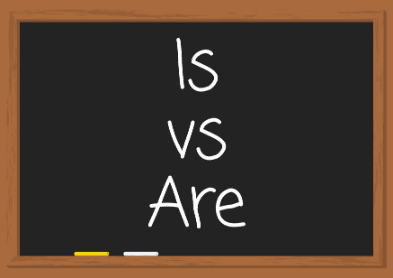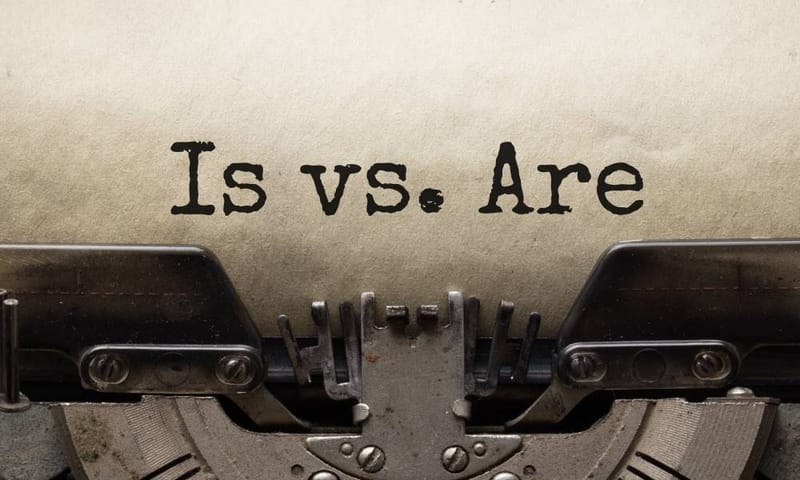The 'Is' vs 'Are' Conundrum: Understanding Subject-Verb Agreement
Contents

Picture yourself in a crucial presentation at work. You confidently say, "The data in these reports are indicating positive growth." Subtle nods around the room quickly turn into puzzled frowns. You've just made a common error - misusing 'is' and 'are'.
Effective communication is the cornerstone of professional success. Using verbs like 'is’ and ‘are’ correctly not only enhances clarity but also builds credibility.
In the following sections, we delve into the basics of is vs are usage, provide numerous real-life is vs are examples, explain when to use is vs are in a sentence, clarify tricky is vs are grammar rules, discuss using is vs are in questions, and more. Let's start.
What are "Is" and "Are"?
To learn the difference between 'is' and 'are', we must analyze their roles as forms of the verb "to be", a key component of sentence structure.
Essentially, 'is' and 'are' help us link the subject of a sentence with the predicate, which can be a noun, adjective, pronoun or phrase that tells us more about the subject.
This brings us to the ‘subject-verb agreement’ rule. Simply put, it signifies that your subject and verb must agree in number. If you have a singular subject, you should use a singular form of a verb like 'is'. And if the subject is plural, the fitting version of 'to be' would be 'are'.
Let's illustrate this with simple examples:
Sunita is going to the market.
Sunita and Ravi are going to market.
In both sentences, we're giving information about Sunita's actions. However, when Ravi joins her making it a plural subject (Sunita and Ravi), we shift from using ‘is’ to ‘are’. This basic use of ‘is’ and ‘are’ is at the heart of forming grammatically correct sentences.
When to Use 'Is'
The word 'is' is used when talking about singular nouns or pronouns. For instance, consider the sentence, "This is a book." Here, 'book' is a singular noun, so we use 'is'. The incorrect usage would be "This are a book", which sounds off because 'are' is used for plural nouns or pronouns.
Here are three tips to remember when to use 'is':
If the noun or pronoun is singular (e.g., he/she/it), use ‘is’.
In sentences with uncountable nouns like ‘music’ or ‘happiness’, always use ‘is’.
When describing one person or thing’s state or action, use ‘is’.
When to Use 'Are'
The word 'are' is used when dealing with plural nouns or pronouns. For example, in the sentence "These are books", 'books' represents more than one item, thus it requires 'are'. The incorrect version would be saying "These is books".
To ensure correct usage of ‘are’, remember these guidelines:
If the noun or pronoun is plural (e.g., they/we), use ‘are’.
In sentences starting with “there” followed by plural objects (e.g., There are people waiting).
When talking about multiple people doing an action or being in a condition, use ‘are’.
Special Cases: Is vs Are Usage Rules
Let's look into some special cases of "is vs are" usage. Understanding these rules can help you speak and write English more accurately and naturally.
Case | Rule | Example |
Collective Nouns | Use 'is' when group acts as one unit | The team is ready for the match. |
Compound Subjects | Use 'are' when subjects are joined by 'and' | Ayesha and Priya are going on a trip. |
Sentences starting with 'there' | Use 'is' for singular, 'are' for plural noun following 'there' |
|
Common Mistakes in Using Is vs Are

In India, where many learn English as a second language, it's not uncommon to see mistakes when using 'is' and 'are'. This is primarily due to translating directly from their native language, where singular-plural distinctions may differ.
One common mistake is mismatching subjects with verbs. For instance, instead of saying "The boxes are heavy," some might say "The boxes is heavy".
Another error is inverting verb and subject order in questions. Many people incorrectly ask "Is the shoes on sale?" instead of “Are the shoes on sale?”.
To avoid these errors, remember this simple rule: 'is' is used with singular nouns and 'are' with plural nouns.
For more insights into commonly made mistakes by non-native English speakers in India, you can explore other topics on our Clapingo blog.
Is vs Are Quiz Time
Ready to test your understanding of 'is' vs 'are'? Let's dive into this multiple-choice quiz!
1. Which is correct?
a) There is many books on the shelf.
b) There are many books on the shelf.
2. Choose the right option:
a) The keys to the car is on the table.
b) The keys to the car are on the table.
3. Fill in the blank:
a) Each of the students ____ required to complete the assignment.
i) is
ii) are
4. Select the right sentence:
a) Here is your pens.
b) Here are your pens.
Answers:
b) There are many books on the shelf - 'Books' is plural, so use ‘are’.
b) The keys to the car are on the table - Even though 'keys' is preceded by 'the', it's still plural, hence ‘are’ fits here.
a) Each of the students is required to complete their assignments - 'Each' implies one at a time, so use ‘is’.
b) Here are your pens - Again, since 'pens' is plural, use ‘are’.
Wrapping Up
To reiterate, understanding the distinction between 'is' and 'are' can significantly improve the grammatical accuracy of your English communication.
The rule of thumb is to use 'is' with singular nouns or pronouns, and 'are' with plural ones. For instance, "This apple is fresh" versus "These apples are fresh". However, as we've seen, there are certain exceptions to this rule, especially when dealing with collective nouns or quantities.
The journey of learning English often involves making mistakes and that's perfectly fine. The more you use these verbs in sentences, the more natural their usage will become.
In case you need additional support in your English learning journey, remember that Clapingo offers personalised learning resources tailored for non-native speakers like you. With a determined attitude and a little help from Clapingo, mastering the 'is vs are' usage will soon be a piece of cake!
FAQs
1. When to use 'is' vs 'are' in a sentence?
The usage of 'is' and 'are' is decided by the subject. If the subject is singular, we use 'is', and if it's plural, we use 'are'. Here are some examples:
Singular: The dog is playing with a ball.
Plural: The dogs are playing with balls.
2. Can I use both 'is' and 'are' in one sentence?
Yes. There are many scenarios where both 'is' vs 'are' can be used within the same sentence. For example, "The book is on the table and the pens are in the drawer."
3. Are there exceptions to 'is' vs 'are' grammar rules?
Yes. Some words may appear plural but require singular verbs like "news", "mathematics", etc. For instance, we say "The news is good" not "The news are good".
Comments
Your comment has been submitted successfully!